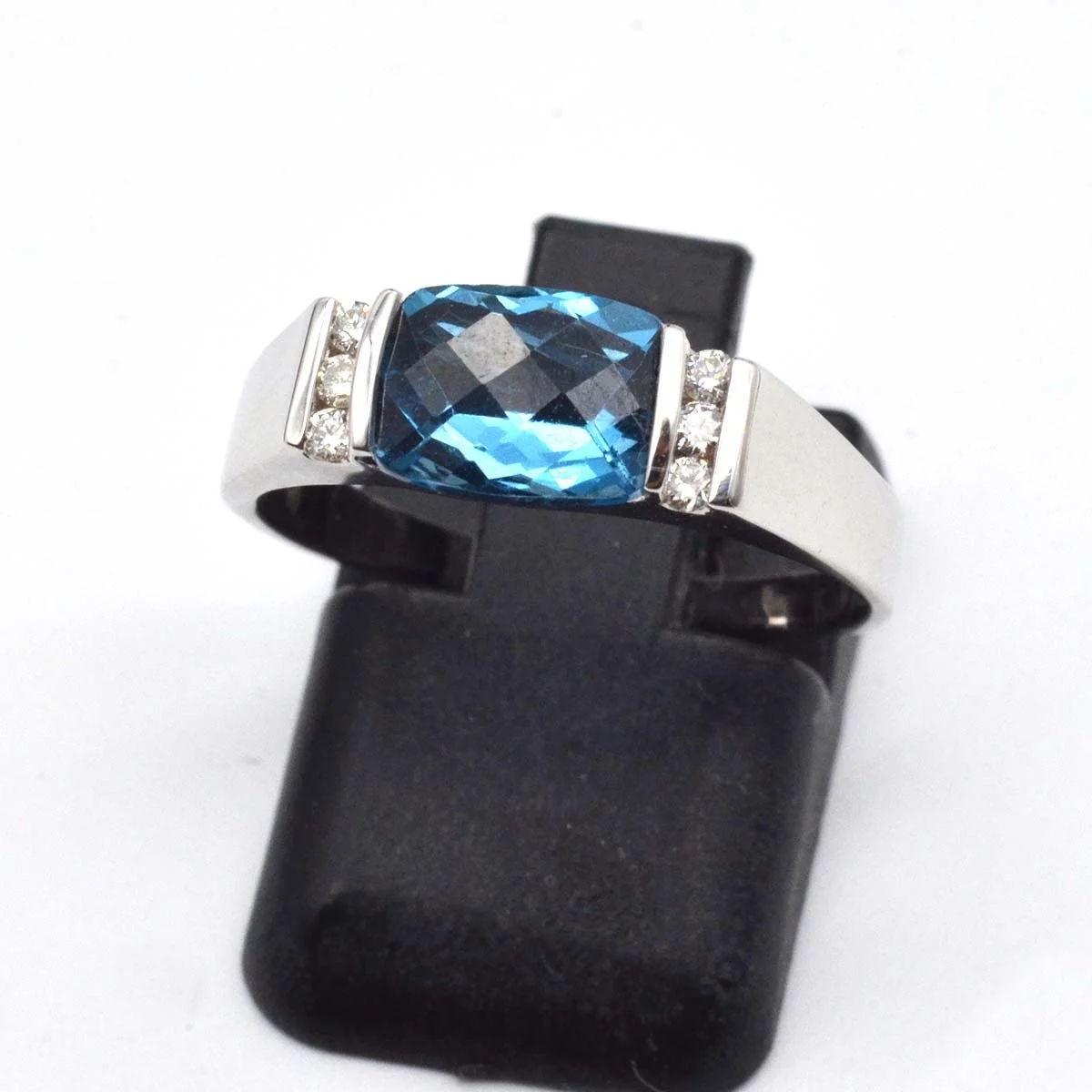Topaz
Topaz is the birthstone of November. Topaz comes in a rainbow of colors. From honey yellow, fiery orange, cyclamen pink, to icy blue, Topaz is a lustrous and brilliant gem.
Definition:
The variety of Topaz hues includes colorless, light blue, yellow, orange, pink, violet, brown and, very rarely red. The vast majority of Blue Topaz seen today is the permanent result of treating colorless topaz with irradiation and heating.
In addition, Topaz is allochromatic, which means that its color is caused by impurity elements or defects in its crystal structure rather than by an element of its basic chemical composition. The element chromium causes natural pink, red, and violet-to-purple colors in topaz. Imperfections at the atomic level in topaz crystal structure can cause yellow, brown, and blue colors. Brown is a common topaz color, and the gem is mistakenly called “smoky quartz”. Topaz is pleochroic, meaning that the gem can show different colors in different crystal directions.
Topaz actually has an exceptionally wide color range that, besides brown, includes various tones and saturations of blue, green, yellow, orange, red, pink, and purple. Colorless Topaz is plentiful, and is often treated to give it a blue color. The color varieties are often identified simply by hue name – Blue Topaz, Pink Topaz, and so forth – but there are also a couple of special trade names. Imperial Topaz is a medium reddish orange to orangey red. This is one of the gem’s most expensive colors. Sherry Topaz – named after the sherry wine – is a yellowish brown or brownish yellow to orange. Stones in this color range are often called Precious Topaz to help distinguish them from the similarly colored, but less expensive, citrine and smoky quartz. The rainbow effect seen in “Mystic Topaz” is created by coating colorless topaz with a thin artificial film.
Shop Topaz Jewelry

The History of Topaz:
Some believe the word “topaz” comes from the Sanskrit word “tapas”, which means “fire”. Others trace it back to the Greek topazios, the old Greek name for a small island in the Red Sea, now called Zabargad. (The island never produced topaz, but it was once a source for peridot, which was confused with topaz before the development of modern mineralogy).
This November birthstone was long thought to have many benefits. The ancient Greeks believed that Topaz gave them strength. In Europe during the Renaissance Period (1300s to the 1600s), Europeans thought it could thwart magic spells and dispel anger. For centuries, many people in India have believed that Topaz worn above the heart assures long life, beauty and intelligence. The distinctly pinkish orange Imperial Topaz has aristocratic cachet in the nineteenth century. It is commonly believed that the name originated with the Russian royal family’s insistence on keeping the finest colors of this gem, which was mined in Russia’s Ural Mountains, exclusively for their use.
An alternate explanation, especially popular in Brazil, is that it dates from an 1881 visit by Brazilian Emperor Pedro II to Ouro Preto – the town closest to Brazil’s most productive topaz mines – and the gift of a reddish topaz to him.
Symbolism:
Topaz is known to have calming energies while bringing fortune and warmth to the wearer. This birthstone is a mellow, empathetic stone that directs energy to where it is needed most. It soothes, heals, stimulates, recharges, remotivates, and aligns the meridians of the body. It promotes truth and forgiveness. Topaz’s vibrant energy brings joy, generosity, abundance, and good health. Traditionally, this birthstone has been known as a stone of love and good fortune, and brings successful attainment of one’s goals.
Psychologically, Topaz helps you to discover your own inner riches. It makes you feel confident and philanthropic, wanting to share your good fortune and spread sunshine all around. This birthstone promotes openness and honesty, self-realization, self-control, and the urge to develop inner wisdom. Mentally, Topaz aids problem-solving and is particularly useful for those engaged in the arts. It helps you to become aware of the influence you have and of the knowledge you have gained through hard work and life experiences. Topaz assists in expressing ideas and confers astuteness.
The landscape of the Muzo region of Colombia
Location:
Minas Gerais, a state in Brazil, is one of the most important sources for high-quality topaz, which has been mined there for more than two centuries. Yellow to orange, red, pink, violet, and blends of red with orange or purple are some of the colors unearthed there. The nearby town of Ouro Preto is a fitting companion. In this UNESCO world heritage site, majestic colonial churches checker the skyline and quaint cobblestone streets crisscross the city. Northwestern Pakistan is known for producing Pink Topaz. Ghundao Hill, close to the small town of Katlang, has been mined since 1972. The most sought-after shade of Pink Topaz from Katlang has a tinge of violet, which some in the gem trade call cyclamen pink. But even at Ghundao Hill, only rarely is this fine pink November birthstone found. Today, other major sources of Topaz include Namibia, Nigeria, Madagascar, Mexico, Myanmar, Sri Lanka, the United States, and the historic Russian localities.
Care & Cleaning:
Topaz is 8 on the Mohs Scale of Hardness, but it has poor toughness, so care is required to avoid chipping or cracking. To clean this November birthstone, do not use steam cleaning or ultrasonic cleaners. Warm, soapy water works best. High heat or sudden temperature changes can cause internal breaks in Topaz.
The birthstone’s color id generally stable to light, but prolonged exposure to heat or sunlight might cause fading in some yellow-to-brown gems. Topaz may be affected slightly by some chemicals. The coating on Mystic Topaz can withstand normal wear, but abrasive cleaners or buffing wheels will remove it. Only a mild soap solution should be used to clean a topaz birthstone treated in this manner.
Why We Love This Gemstone
Kilos: Topaz comes in some of the gem world’s largest crystals: the largest are kilos, not carats.
Slippery: Faceted Topaz takes such a high polish, it’s slightly slippery to the touch.
Pleochroic: Topaz is pleochroic, displaying different colors in different crystal directions.
Topaz comes in a variety of colors from shades of blue to the rare reddish imperial colors.
COLOR
The most valued Topaz colors are orangey red to red. Blue gems are widely available.
CLARITY
Topaz used in jewelry is typically eye clean with no visible inclusions.
CUT
Topaz crystals are usually columnar, and cut as oval or pear shapes to improve yield.
CARAT
Topaz often forms as large crystals. These can yield sizable cut gems.
Need help selecting an amazing gift?
We all need a little help sometimes. Whether the gift is for someone special or even yourself, let us guide you. Give us a call or drop us an email.









Description goes here
Make it a set with the matching 14K yellow gold Blue Topaz Earrings!
14K Yellow Gold
Faceted Blue Topaz
Chain is not included - Purchase a Chain Separately.